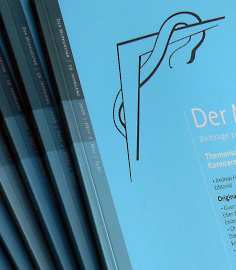
HEFT 1/2025
Der Merkurstab | Januar/Februar 2025 | 22,00 Euro (inkl. Mwst., zzgl. Versandkosten)

| Artikel | Betrachtungen zum Kapitel XIV der GA 27: „Von der therapeutischen Denkweise“ Reflections on Chapter XIV of CW 27: “An Approach to the Therapeutic Way of Thinking” |
| Autor | Albrecht Warning |
| Seiten | 031-036 |
| Volume | 78 |
Zusammenfassung
Wie lässt sich aus dem Text des Kapitels XIV der GA 27
die therapeutische Denkweise entwickeln? Die kosmischen
Lichtkräfte der Kieselsäure als Sinnesorgan der
Erde führen zu einer Betrachtung des menschlichen
Auges. Dessen Bildungsprozess von embryonaler
Lebensaktivität zum lebensarmen durchlichteten
Grenzorgan als Kieselsäureprozess ist Vorbild für die
Gedankenbildung in der Begegnung mit den Patient:innen. Unvoreingenommenes Wahrnehmen führt
zur „richtigen Meinung“ – ein erster Schritt eines
Übungsweges zur therapeutischen Denkweise. Die
Klärung der Interferenz zwischen Patient und Krankheitswesen
ergibt ein Gedankenbild: „das richtige
Urteil“. Das Erüben des eurythmischen Lautes „M“
als Atmungsvorgang befähigt, analog zur Wahrnehmungskraft
im Kieselsäureorganismus, zu einer bewusst
erlebten Empfindsamkeit für das leiblich-seelische
Gefüge des Patienten. So lässt sich ein Therapiebedarf
erkennen, mit dem der Krankheitsverlauf begleitet
wird: Dies ist „die richtige Tat“. Die beiden Beispiele,
die als Heilmittelindikation der Kieselsäure
im Kapitel XIV beschrieben sind, werden gespiegelt
und kommentiert.
Abstract
How can an approach to the therapeutic way of thinking
be developed from the text of Chapter XIV of CW
27? The cosmic light forces of silicic acid as the sensory
organ of the earth lead to a consideration of the
human eye. Its formation process from embryonic life
activity to the life-poor, translucent boundary organ
as a silicic acid process is the model for the formation
of thoughts in the encounter with the patient. Unbiased perception leads to the “right opinion” – a first
step on the path to a therapeutic way of thinking. The
clarification of the interference between patient and
illness results in a mental image: “the correct judgement”.
Practising the eurythmic sound “M” as a
breathing process, analogous to the power of perception
in the silicic acid organism, enables a consciously
experienced sensitivity for the patient’s physical and
mental constitution. In this way, a need for therapy
can be recognised to accompany the course of the
disease: This is “the right action”. The two examples
described in Chapter XIV as indications for silicic acid
as a remedy are mirrored and commented on.
